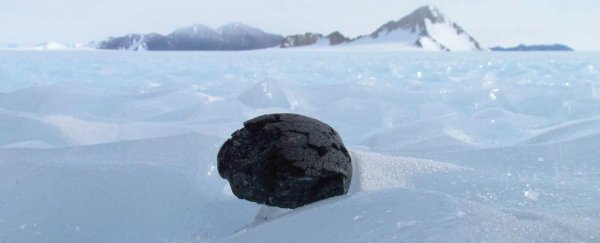It's estimated that thousands of meteorites enter Earth's atmosphere every year, and of those, the majority that are recovered are found in Antarctica. How come? One of the reasons is simply because, against the barren white backdrop of Antarctic wilderness, it's easier to spot the space rocks, which are often dark in colour.
But for a specific kind of meteorite – those rich in iron – far fewer have ever been found in Antarctica, providing a long-running mystery that has puzzled scientists for decades. Now, a new study by researchers in the UK could offer a solution to the riddle: iron-rich meteorites in Antarctica are rarely found because they're perpetually heating up in the Sun's rays and melting the surface, falling downwards below the top layer of the ice sheet.
"The study is proposing a hypothesis – these samples should be there [under the ice]," one of the researchers, Katherine Joy from the University of Manchester, told Jonathan Webb at BBC News. "We just have to go and locate them."
The team believes this unseen trove of iron-rich meteorites could be hiding just centimetres below the surface, but that their high metallic content is effectively making them into heatsinks fuelled by the Sun's rays. Unlike non-metallic meteorites, their capacity to get hotter during the day means they're much harder to find, as they're forever sinking below the visible surface.
Apart from the visual contrast in their appearance, the other reason non-metallic meteorites are so often found in Antarctica is due to ice flow dynamics, which transport meteorites buried in the ice upwards to localised surface regions called Meteorite Stranding Zones (MSZs).
It's in these MSZs that some two-thirds of meteorites on Earth are found, but according to the researchers, the flow dynamic is impeded or negated by the heat of iron-rich meteorites. The icy phenomenon may be able to lift buried rocks, but it can't do its job properly if those rocks become hot and melt it away.
"[This] continuous conveyor belt has delivered meteorites from the interior fall sites to the 'meteorite stranding zones' for the past couple of million years or so," said Joy. Unless the meteorites are highly metallic, that is. If they are, "they never make it to the surface. They're forever trapped, 50–100 cm or so below the ice."
The team's findings, published in Nature Communications, are based on mathematical modelling that shows that thawing and freezing processes can cancel out the upward transportation of meteorites with high thermal conductivity – such as rocks rich in iron – while those with lower conductivities rise unimpeded to the ice surface.
The next step, now that we know there's a good chance these iron-rich meteorites may be there after all, is to find and study them, with radars and metal detectors likely to prove crucial in the search.
"With the strong possibility that a hidden reserve of meteorites lies just below the ice surface of localised areas of Antarctica, finding conclusive evidence of its existence is imperative to our understanding of the Solar System's formation," said lead researcher Geoff Evatt in a press release. "The challenge is now set: to be the first team to locate this reserve of meteorites and retrieve samples from it."
